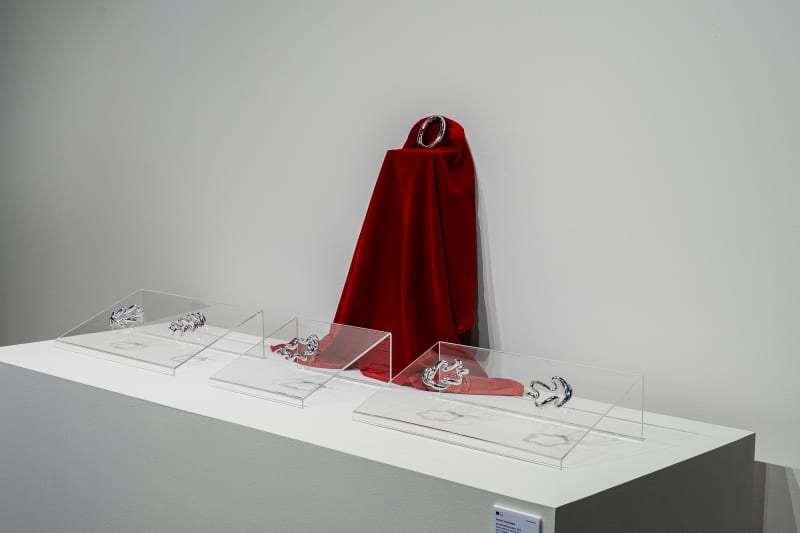The dialogue of faith is constantly monotonous and continuous over time. It is a conversation between the blurred lines between “faith” and “superstition.” It repeatedly appears while satirizing, criticizing, opposing, and arguing. However, the dialogue of faith continues to take shape and become an attribute that can be revolved around, changing its appearance and blending in throughout the period.
“Mu Te Lu: Ilmu Teluh” is a group exhibition by four artists presenting their interpretation of faith. Through applied art, create a dialogue through the dynamics of belief mixed with contemporary perspectives. Converting the appearance of sacred objects, tattoos, talismans, or even the belief into a different shape and form still maintains the core of the traditional belief. The convergence of applied art and faith not only transforms but also diminishes, or it may break the pattern of symbolic systems, rituals, or areas of power and possibly lead to the formation of a new sacred image.
Noon Passama’s zero-to-nine numbers bracelet dilutes the symbolic meaning and creates an abstract form. Individual numbers, odd and even, are not only synonymous with different cultures but are also directed subjectively to preferences such as liking, bonding, being lucky, or being drawn into a specific number. The meaning of each number can therefore twist, flow and disintegrate inconstantly. Numerology has a specific meaning specific to people, so the appearance of the number may not be as important as the meaning embedded by society for ages. Beliefs may only weigh on shared memories with the measurement called subjectivity.
It may not be the modern dynamics that oppose the object of belief and superstition, but rather the shell, texture, or the true nature of the faith itself that resists the process of going in-depth into it. It must adhere to the surface of the ideal or mythical appearance or the iconography of the sacred. Jun Sekino not only creates sacred vertical-horizontal wooden frame sculptures but also questions the images representing beliefs that exist in contemporary society. Through the view of boundless faith. It shows that although current beliefs are forming, they might be initially there—only adjusting the display to keep up with the times.
Pelagan S. reduced the rawness of symbols and characters on the talisman and presented it as a painting. The important part is different from how the talisman is given. Still, the critical factor is how the talisman is adapted from the original pattern and what meaning each piece of talisman must hold with the identity being deducted from the original. Its essence lies in the process of reading and reducing the tattooed talisman to only the core of the pattern while does not abandon the original design or its original meaning.
In the form of belief, the Eiair’s insect amulets, was therefore not only a re-establishment of the sacred, but it also brought us back to observation in nature and brought back to replace the image of the sacred thing again. Bringing art and belief back to the oldest process, copying from nature, Eiair doesn't just replicate but points out the holiness that reverts to nature.
Art doesn’t just merge legends, phenomena, and possibilities. They are not only compiling the body of faith to create an image for the sacred or setting up a symbolic system to indicate authority and power, but Applied Art presents itself to seek the possibility of belief and contemporary work. On the overlapping borders of art and religion, including the boundaries of class and culture. The work of Ilmu teluh may also reflect the search for the value of themselves or secure meaning in life. Ultimately, humans may pursue areas beyond phenomenological perception and the conceptual space of truth in personal ideology. A unique ideology that binds us to others and merges into a group of people who share the same beliefs. Same power, the same ritual, or objects of the exact nature. Finally, a dialogue of endless faith and questions on the line between religion and superstition, reality and imagination, coincidence or supernatural event. It could all be pinned down to one crucial question, and perhaps the only question that decisive judges the split-second conversation of faith if it has been answered: “Do you believe?”
The exhibition “Mu Te Lu: Ilmu Teluh” will be held on the first floor of Art Centre Bldg., SAC Gallery from 11 February until 6 May 2023. The official opening ceremony will be held on 11 February 2023, 6:00PM onwards.
Hashtag: #SACIlmuTeluh
ความเชื่อ หนึ่งบทสนทนาที่ซ้ำซาก และต่อเนื่องบนเส้นกาลเวลา เป็นบทสนทนาที่โต้เถียงระหว่างคำ “เชื่อ” หรือ “งมงาย” แม้จะโดนวิพากษ์ ต่อต้าน ไปจนถึงการปักป้ายความงมงาย แต่กิจของความเชื่อกลับยิ่งเป็นที่นิยม ความน่าสนใจจึงเป็นการดำรงอยู่ในฐานะแรงขับเคลื่อนที่แยกขาดไม่ได้จากสังคมในทุกช่วงของยุคสมัยและกาลเวลาของความเชื่อ
“มู เต ลู: Ilmu Teluh” นิทรรศการกลุ่มว่าด้วยรูปลักษณ์ของความเชื่อในโลกร่วมสมัย โดยศิลปิน Applied Art สี่ท่านที่มีมุมมองและกระบวนการทำงานจากศาสตร์ต่างแขนง นำเสนอรูปลักษณ์ของสิ่งศักดิ์สิทธิ์ วัตถุมงคล ลายสักยันต์ และศาสตร์ความเชื่อ ที่ไม่ใช่เพียงการออกแบบรูปลักษณ์ให้เข้าถึงง่าย แต่ยังเป็นการตามหารูปลักษณ์ที่งานศิลปะและความเชื่อเป็นมากกว่าวัตถุมงคล หรือสิ่งกราบไหว้บูชา แต่สามารถกลมกลืนไปกับพื้นที่ชีวิตประจำวัน ผ่านการใช้ Applied Art เข้ามาเปลี่ยนแปลงรูปลักษณ์ ระบบสัญลักษณ์ และพิธีกรรม ไปจนถึงสร้างรูปลักษณ์ของสิ่งศักดิ์สิทธิ์ขึ้นใหม่
Noon Passama กับผลงานกำไลเลขศูนย์ถึงเก้า กำไลที่สลายรูปลักษณ์ของตัวเลข และแสดงให้เห็นถึงความหมายที่ไม่คงตัว และแตกต่างกันไปในแต่ละวัฒนธรรม รวมถึงความหมายผูกโยงกับการใช้ชีวิต ตั้งแต่การเป็นเลขที่ถูกโฉลก เลขประจำตัว เลขจำนวนของบางสิ่ง หรือช่วงเวลาที่สำคัญ กำไลของ Noon Passama จึงไม่ใช่ตัวเลขแต่เป็นการบิดและไหล เพื่อสมดุลย์ความหมายในรูปลักษณ์กับความหมายของเลขที่แต่ละคนมอบให้ ทั้งยังทำให้เห็นส่วนสำคัญของความเชื่อที่อาจไม่ได้ถูกจำกัดไว้ด้วยอำนาจ วัฒนธรรมหรือตำนาน ส่วนสำคัญนั้นอาจเป็นคุณค่าจากความทรงจำกับสิ่งที่ประสบพบเจอ
บทสนทนาถึงความเชื่อ/งมงาย ยังอาจเกิดจากลักษณะเดิมของความเชื่อ ที่ยึดติดอยู่บนผิวของรูปลักษณ์อุดมคติหรือรูปลักษณ์ดั้งเดิม ผลงานประติมากรรมสิ่งศักดิ์สิทธิ์ของ Jun Sekino จึงแสดงถึงมุมมองการก่อร่างโครงสร้างของความเชื่อที่ไม่ได้ถูกจำกัดด้วยรูปลักษณ์ตามความเชื่อ ทั้งประติมากรรมโครงไม้แกนตั้ง-นอน ลักษณะคล้ายคนเข้าฌาน และศาลพระภูมิบ้านสมัยใหม่ถอดประกอบได้ จึงเป็นสองภาพแทนของการไม่ยึดอยู่กับลักษณะเดิม และแสดงถึงความสำคัญของกระบวนการสร้างและดำรงอยู่ตามยุคสมัย ทั้งยังบอกถึงความเชื่อในโลกสมัยใหม่ ที่กำลังปรับรูปลักษณ์ให้เท่าทันต่อกาลเวลา
ยันต์ เป็นอีกรูปแบบหนึ่งของความเชื่อที่สำคัญ และปรากฏในเกือบทุกวัฒนธรรม ยันต์ยืนยันถึงความเชื่อที่เป็นมากกว่าการสนองแรงปรารถนา หรืออธิบายสิ่งเหนือขอบเขตความเข้าใจ แต่ยังบอกถึงความต้องการหลักประกันในชีวิต ศิลปิน Pelagan S. ได้ศึกษาถึงเสน่ห์ของยันต์ทั้งความหมายที่ถูกสร้างผ่านลวดลาย และการจัดเรียงของระบบสัญลักษณ์ นำยันต์มาลดทอนรูปลักษณ์ที่ดูดุ ดิบ หรือเก่าแก่ลง ทั้งยังทำให้เห็นถึงการคงไว้ซึ่งความหมายบนรูปลักษณ์ใหม่ นอกจากนี้ยันต์ของ Pelagan S. ยังชี้ชวนให้สนทนาถึงความงามที่เป็นไปได้ และความหมายของความเชื่อที่ดำรงอยู่ในโลกสมัยใหม่
เมื่อกล่าวถึงรูปลักษณ์ของความเชื่อ ละเลยไปไม่ได้ถึงการสร้างความเชื่อและสิ่งศักดิ์สิทธิ์ ศิลปิน Eiair ได้สร้างเครื่องรางแมลง เป็นการกลับไปสู่กระบวนการเก่าแก่ของศิลปะและศักดิ์สิทธิ์ ที่เริ่มต้นจากการสังเกตและถอดแบบธรรมชาติ ทั้งยังทำให้เห็นถึงการกำเนิดของความเชื่อ ที่เรานั้นจำเป็นต้องสังเกตให้เห็นถึงอณูเนื้อทุกขมวดปมเล็กใหญ่ เห็นถึงความละเอียดลออ และเห็นความเป็นไปจากสิ่งรอบตัว เช่นเดียวกับงานของ Eiair ที่จำต้องดูอย่างเห็นในรายละเอียด และจินตนาการความสามารถ อำนาจ และพลังจากรูปลักษณ์ของสิ่งที่เห็น และความเป็นไปได้ของสิ่งที่เชื่อ
ภายในกระบวนการทำงานของทั้งสี่ศิลปิน แฝงไปด้วยการพินิจถึงรูปลักษณ์ที่เป็นไปได้ของสิ่งศักดิ์สิทธิ์ โดยใช้ Applied Art เชื่อมต่อระหว่างความหมาย คุณค่า พลังอำนาจ ไปจนถึงรูปลักษณ์ที่สามารถกลมกลืนได้กับโลกสมัยใหม่ ดั่งความเชื่อในปัจจุบัน ที่อยู่ในทุกพื้นที่ ชนชั้นและวัฒนธรรม วัตถุแห่งความเชื่อจึงเป็นมากว่าการมีไว้เพื่อบูชา นิทรรศการ “มู เต ลู: Ilmu Teluh” จึงอาจเป็นทั้งการนำเสนอความเป็นไปได้ของความเชื่อในเป็นไปของโลกสมัยใหม่ และเป็นทั้งการยินยอมให้ความเชื่อกินกลืนเข้ามาในชีวิตประจำวัน บทสนทนาและคำถามไม่รู้จบของความเชื่อหรือความงมงาย สิ่งเหนือการอธิบายกับความบังเอิญ ความจริงและจินตนาการ ทั้งหมดอาจเป็นเพียงบทสนทนาที่บอกถึงการตามหาแรงขับของคนสังคม ตั้งแต่คุณค่า ความหมาย ไปจนถึงการตามหาหลักประกันในชีวิต หรืออาจเป็นเพียงการตามหาพื้นที่ในมโนภาพของความจริงส่วนบุคคล บนอุดมการณ์ที่ผสานรวมกลุ่มบุคคลผู้มีความเชื่อในสิ่งเดียวกัน สู่พลังงานเดียวกัน หรือพิธีกรรมเดียวกัน
นิทรรศการ “มู เต ลู: Ilmu Teluh” จัดแสดงระหว่างวันที่ 11 กุมภาพันธ์ - 6 พฤษภาคม พ.ศ. 2566 ณ ชั้น 1 อาคารหอศิลป์ (ตึกใหญ่) เอส เอ ซี แกลเลอรี (SAC Gallery) โดยมีพิธีเปิดนิทรรศการในวันที่ 11 กุมภาพันธ์ พ.ศ. 2566 ตั้งแต่เวลา 18:00 น. เป็นต้นไป
